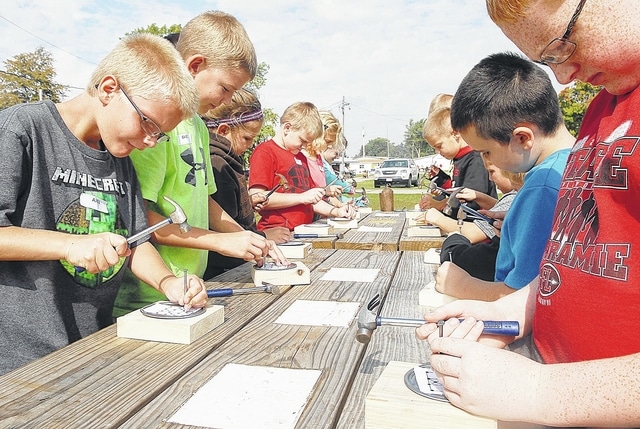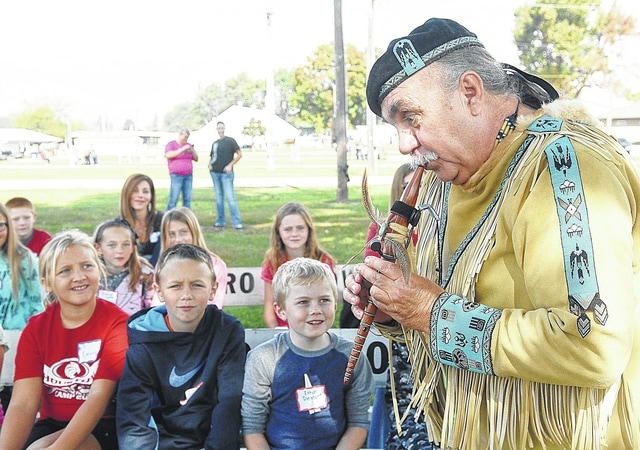

SIDNEY — Fourth-grade students in Shelby County traveled back in time Wednesday as they attended the 11th Pioneer Day held at the Shelby County Fairgrounds.
“This is a generational educational day,” said Tilda Phlipot, Shelby County Historical Society director. “We sometimes ask ourselves — are we doing this for the fourth-graders in the county to learn about pioneers? Or are we doing it for the high school students so they can share their leadership skills? Or are we doing it for the seniors who are sharing their lives with the younger children?”
And, said Philipot, the answer to each question is “yes.”
Every school in Shelby County was represented at the event, she said. There were also some homeschooled children in attendance. Upper Valley Career Center sent their teacher academy students who added their leadership skills to the program.
Because of the early morning dense fog, school in the county was delayed up to two hours. Russia Local Schools canceled school for the day.
“We had Russia parents distraught this morning (Wednesday) because their children couldn’t attend,” said Phlipot. “They called and asked if we would welcome their students. So one van filled with students and one parent made the foggy morning trek to make sure their students would benefit from the day.
“That is a sign of the dedication of the parents in this community for the program,” she said.
The students were divided up into three groups. They visited eight different stations and participated in 10 different events. They learned about transportation, schools, Native Americans, how to make quilt squares, the tinsmith industry, hunt, games, farming tools, food processing and the wetlands.
“We have three of everything going,” said Lynda Adams, Shelby Soil and Water Conservation District education specialist. “We have 200 volunteers helping with the program. Most of them have done it before.”
Because of the delay in the morning start, said Adams, each station was 15 minutes in length instead of 25 minutes.
“The first settlers walked everywhere they went,” said Andy Hite, who headed up one of the transportation stations. “As our ancestors got here, they cleared the land.”
The settlers, he said, then built a cabin for their family to live in and began planting crops. Their gardens, he said, quickly grew into fields and the family had more produce/livestock than they needed.
Hite told the students that the pioneers then faced the question of how to sell their products.
“They needed to get it out of Shelby County,” said Hite. “They could only walk or they rode in a wagon. The closest big city was Cincinnati.”
The farmers, he said, would have to spend a long time in a wagon to get to Cincinnati. And they would have to figure out how much they could put in the wagon.
“How could they get their pigs to Cincinnati to sell?” he asked. “They could walk, but the pigs would be so skinny by the time they got there, they wouldn’t be worth anything.”
In 1825, he said, the state of Ohio decided to do something to help the farmers. They decided to have a series of canals built in the state.
“If they could get to Lake Erie, then they could get to New York City. Then they could get their goods to England,” said Hite.
From 1825 to 1845, the state had 1,000 miles of canals built. The canals were 40 feet wide and four foot deep. Wheelbarrows, picks and shovels were used to dig out the canals.
The Miami-Erie Canal, which is the closet canal to Shelby County, is 266 miles long, said Hite.
At the wetlands station, the students learned about the grass and foliage found in the area. The wetlands holds the water on top of it because there’s clay underneath the soil.
They also saw pelts of different animals and skulls of foxes, coyotes and deer.
As one group entered the pioneer school, they were greeted by Jan Augenstein and Carol Robinson, of Marion, Ohio. They talked about what a day is like in a one-room log cabin school. Students, they said, would write with a feather pen which was called a quill. The feathers were found everywhere and the teacher would use a pen knife to sharpen the feather so the students could write with them.
Greg Ward talked about the different types of farm tools the pioneers used when planting their crops. A corn dotter was used to plant one seed at a time. The seeds would be placed in the dotter and the farmer would open it up and then close it to put the seed into the ground.
A dibbler was used to poke a hole in the ground, he said. The farmer would then bend over and put the seed in the ground and then cover it up with soil.
On group of students learned how apple butter is made. The second group learned about making apple cider. Applesauce was the station for the final group of students.
Adams said the Shelby County Sheriff’s work crew and members of the Fairlawn FFA helped set up and tear down the stations, said Adams.
“We started Monday to set up,” she said. “It’ll be Thursday by the time tear down is complete.”
The Pioneer Day was first established in 2004 when the first Applefest festival was held.
“We started this when we thought Applefest would be around for one year,” said Phlipot. “This is an educational component for the children of our county.”
Sponsors of the event are the Shelby County Community Foundation, Shelby County United Way, Shelby County Historical Society, Shelby Soil and Water Conservation District, Sidney-Shelby County Chamber of Commerce, Emerson Foundation and Monarch Legacy Fund.



